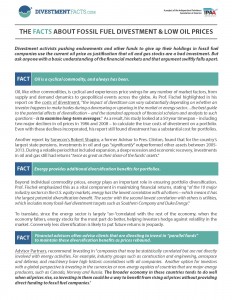 Divestment activists pushing endowments and other funds to give up their holdings in fossil fuel companies are using the current oil price as justification that fossil fuel stocks are a bad investment. But a quick look at the facts tells a much different story.
Divestment activists pushing endowments and other funds to give up their holdings in fossil fuel companies are using the current oil price as justification that fossil fuel stocks are a bad investment. But a quick look at the facts tells a much different story.
In reality, oil prices, like all other commodities, are cyclical and rely on a variety of market factors. The key, however, is the reliability and economic value of these resources over time. As Prof. Fischel highlighted in his report on the costs of divestment, “the impact of divestiture can vary substantially depending on whether an investor happens to make trades during a downswing or upswing in the market or energy sector…the best guide to the potential effects of diversification – and the standard approach of financial scholars and analysts to such questions – is to examine long-term averages.” As a result, his study looked at a 50 year timespan – including two major declines in oil prices in 1986 and 2008 – to calculate the true costs of divestment on a portfolio. Even with these declines incorporated, his report still found divestment has a substantial cost for portfolios.
Beyond individual commodity prices, energy plays an important role in ensuring portfolio diversification. Even financial advisors helping their clients to divest often recommend investing in countries and companies “involved in energy activities” as a way to take advantage of inevitable upswings in the market. That is in large part, as Advisor Partners explains, because “the broader economy in these countries tends to do well when oil prices rise, so investing in them could be a way to benefit from rising oil prices without providing direct funding to fossil fuel companies.”
Fossil fuels are also set to maintain a key role in the global energy market, with the Energy Information Administration (EIA) estimating that “global consumption of petroleum and other liquid fuels to continue to grow by 1.2 million b/d in 2016 and by 1.5 million b/d in 2017.” In the long term, EIA also sees fossil fuels supplying 80 percent of the world’s energy by 2040. Meanwhile, natural gas has been called an excellent complement to growing alternative fuels, including by Secretary of the Department of Energy Ernest Moniz who stated natural gas “can play an important role over the next couple of decades (together with demand management) in economically advancing a clean energy system.” Rhone Resch, CEO of the Solar Energy Industries Association, has also stated that “natural gas and renewables complement each other very nicely.”
Divestment advocates themselves also recognize that removing investments from fossil fuels just because of today’s prices is limited since prices will inevitably change overtime. Even 350.org activist Naomi Klein stated recently that, “Fossil fuel stocks aren’t performing very well right now. So opponents have just lost their best argument. They won’t lose it for long. So that’s another reason to pound away at it.” In fact, rather than divest from funds, a savvy investor will frequently take advantage of low prices to maximize gains over a longer timeframe.
For more on the real facts behind divestment and low oil prices, check out our new fact sheet The Facts on Fossil Fuel Divestment & Low Oil Prices.